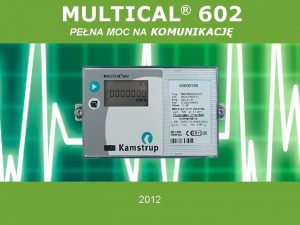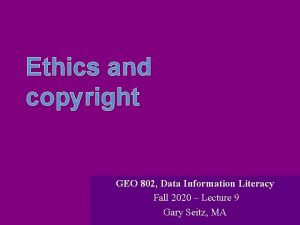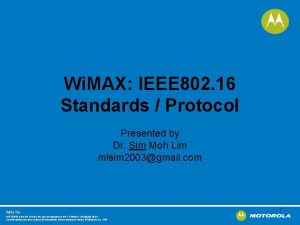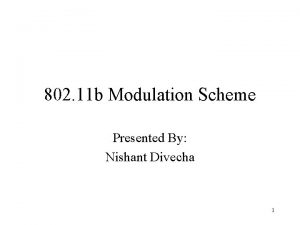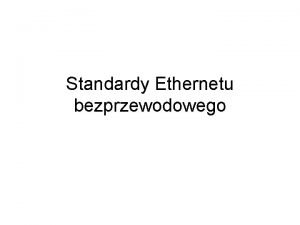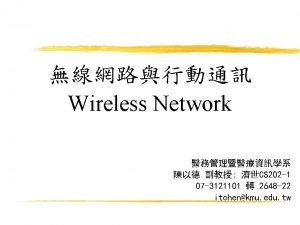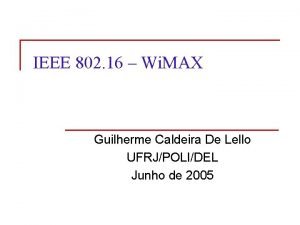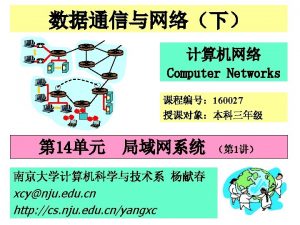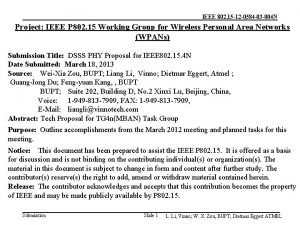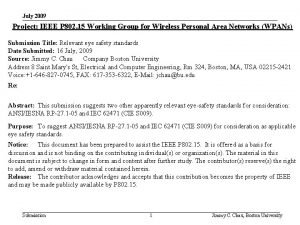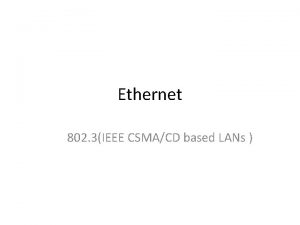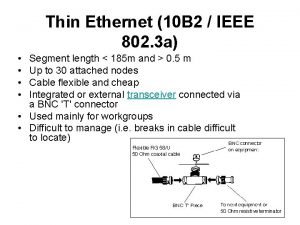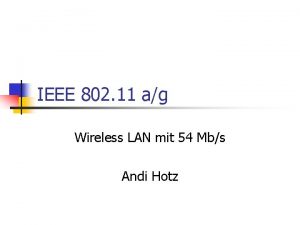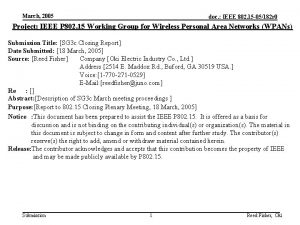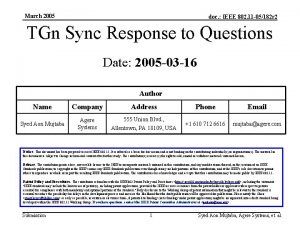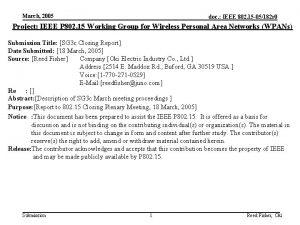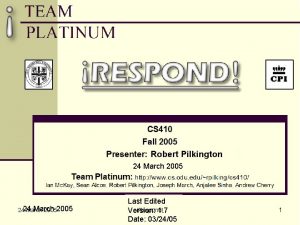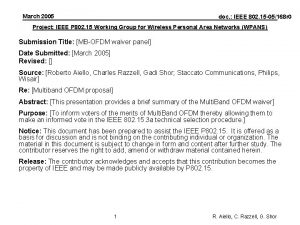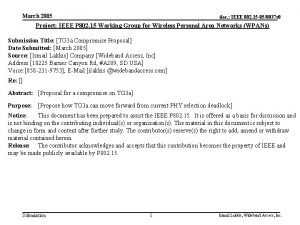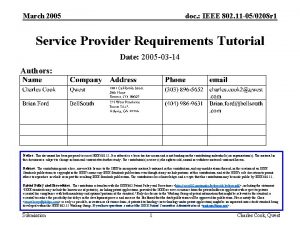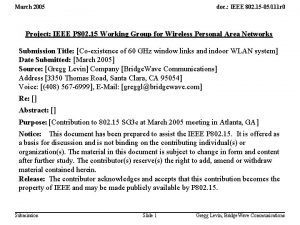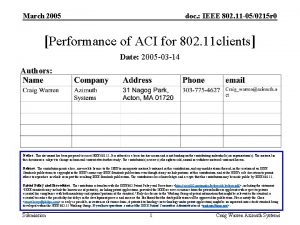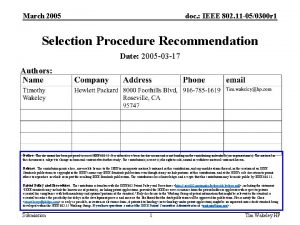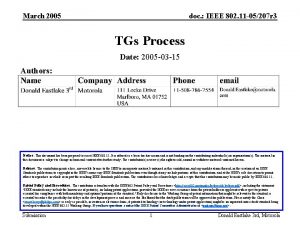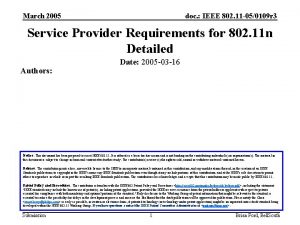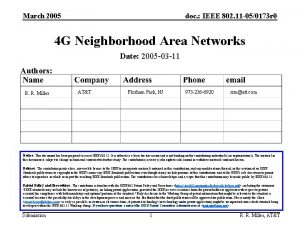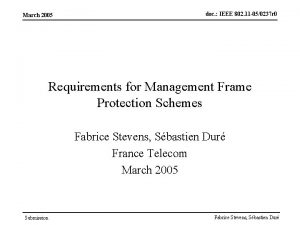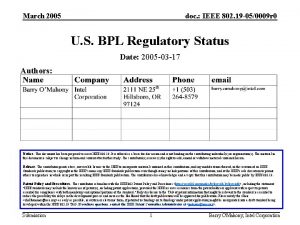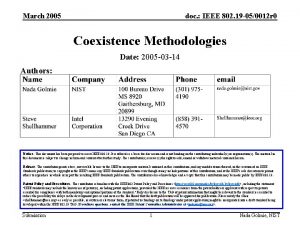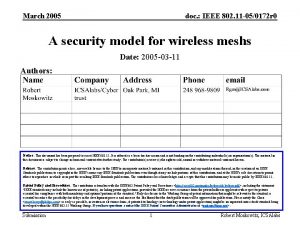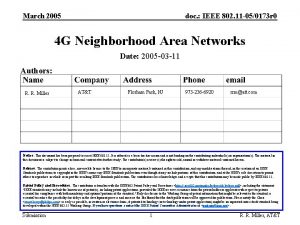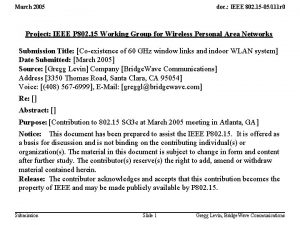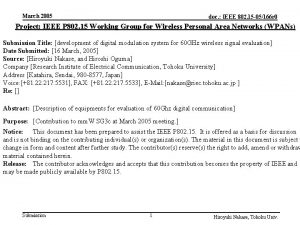March 2005 doc IEEE 802 11 05182 r




























- Slides: 28

March 2005 doc. : IEEE 802. 11 -05/182 r 0 TGn Sync Response to Questions Date: 2005 -03 -11 Author Name Company Address Phone Email Syed Aon Mujtaba Agere Systems 555 Union Blvd. , Allentown, PA 18109, USA +1 610 712 6616 mujtaba@agere. com Notice: This document has been prepared to assist IEEE 802. 11. It is offered as a basis for discussion and is not binding on the contributing individual(s) or organization(s). The material in this document is subject to change in form and content after further study. The contributor(s) reserve(s) the right to add, amend or withdraw material contained herein. Release: The contributor grants a free, irrevocable license to the IEEE to incorporate material contained in this contribution, and any modifications thereof, in the creation of an IEEE Standards publication; to copyright in the IEEE’s name any IEEE Standards publication even though it may include portions of this contribution; and at the IEEE’s sole discretion to permit others to reproduce in whole or in part the resulting IEEE Standards publication. The contributor also acknowledges and accepts that this contribution may be made public by IEEE 802. 11. Patent Policy and Procedures: The contributor is familiar with the IEEE 802 Patent Policy and Procedures <http: // ieee 802. org/guides/bylaws/sb-bylaws. pdf>, including the statement "IEEE standards may include the known use of patent(s), including patent applications, provided the IEEE receives assurance from the patent holder or applicant with respect to patents essential for compliance with both mandatory and optional portions of the standard. " Early disclosure to the Working Group of patent information that might be relevant to the standard is essential to reduce the possibility for delays in the development process and increase the likelihood that the draft publication will be approved for publication. Please notify the Chair <stuart. kerry@philips. com> as early as possible, in written or electronic form, if patented technology (or technology under patent application) might be incorporated into a draft standard being developed within the IEEE 802. 11 Working Group. If you have questions, contact the IEEE Patent Committee Administrator at <patcom@ieee. org>. Submission 1 Syed Aon Mujtaba, Agere Systems, et. al.

March 2005 doc. : IEEE 802. 11 -05/182 r 0 Additional Authors: Name Company email Adrian P. Stephens Intel Corporation Adrian. p. stephens@intel. com Alek Purkovic Nortel Networks apurkovi@nortelnetworks. com Andrew Myles Cisco Systems amyles@cisco. com Andy Molisch Mitsubishi Electric molisch@merl. com Brian Hart Cisco Systems brianh@cisco. com Brian Johnson Nortel Networks brjohnso@nortelnetworks. com Chiu Ngo Samsung Electronics Co Ltd chiu. ngo@samsung. com Daisuke Takeda Toshiba Corporation daisuke. takeda@toshiba. co. jp Daqing Gu Mitsubishi Electric dgu@merl. com Darren Mc. Namara Toshiba Corporation Darren. Mc. Namara@toshiba-trel. com Dongjun (DJ) Lee Samsung Electronic Co Ltd djthekid. lee@samsung. com David Bagby Calypso Consulting david. bagby@ieee. org Eldad Perahia Cisco Systems eperahia@cisco. com Hiroshi Oguma Tohoku University oguma@wit. riec. tohoku. ac. jp Hiroyuki Nakase Tohoku University nakase@riec. tohoku. ac. jp Huanchun Ye Atheros Communications hcye@atheros. com Hui-Ling Lou Marvell Semiconductor hlou@marvell. com Isaac Lim Wei Lih Panasonic wllim@psl. com. sg James Chen Marvell Semiconductor jamesc@marvell. com J. Mike Wilson Intel Corporation james. mike. wilson@intel. com Jan Boer Agere Systems janboer@agere. com Submission 2 Syed Aon Mujtaba, Agere Systems, et. al.

March 2005 doc. : IEEE 802. 11 -05/182 r 0 Jeff Gilbert Atheros Communications gilbertj@atheros. com Jin Zhang Mitsubishi Electric jzhang@merl. com Job Oostveen Royal Philips Electronics job. oostveen@philips. com Joe Pitarresi Intel Corporation joe. pitarresi@intel. com Jorg Habetha Royal Philips Electronics joerg. habetha@philips. com John Sadowsky Intel Corporation john. sadowsky@intel. com Jon Rosdahl Samsung Electronics Co Ltd jon. rosdahl@partner. samsung. com Kiyotaka Kobayashi Panasonic kobayashi. kiyotaka@jp. panasonic. com Li Yuan Institute for Infocomm Research liyuan@i 2 r. a-star. edu. sg Luke Qian Cisco Systems lchia@cisco. com Mary Cramer Agere Systems mecramer@agere. com Masahiro Takagi Toshiba Corporation masahiro 3. takagi@toshiba. co. jp Monisha Gosh Royal Philips Electronics monisha. ghosh@philips. com Osama Aboul-Magd Nortel Networks osama@nortelnetworks. com Paul Feinberg Sony Electronics paul. feinberg@am. sony. com Pen Li Royal Philips Electronics pen. li@philips. com Peter Loc Marvell Semiconductor ploc@marvell. com Pieter-Paul Giesbert Agere Systems pgiesberts@agere. com Submission 3 Syed Aon Mujtaba, Agere Systems, et. al.

March 2005 doc. : IEEE 802. 11 -05/182 r 0 Richard van Leeuwen Agere Systems rleeuwen@agere. com Ronald Rietman Royal Phiips Electronics ronald. rietman@philips. com Seigo Nakao Sanyo Electric Co Ltd snakao@gf. hm. rd. sanyo. co. jp Sheung Li Atheros Communications sheung@atheros. com Stephen Shellhammer Intel Corporation stephen. j. shellhammer@intel. com Sumei Sun Institute for Infocomm Research sunsm@i 2 r. a-star. edu. sg Taekon Kim Samsung Electronics Co Ltd taekon. kim@samsung. com Takashi Fukugawa Panasonic fukagawa. takashi@jp. panasonic. com Takushi Kunihiro Sony Corporation kuni@wcs. sony. co. jp Teik-Kheong (TK) Tan Royal Philips Electronics tktan@philips. com Tomoko Adachi Toshiba Corporation tomo. adachi@toshiba. co. jp Tomoya Yamaura Sony Corporation yamaura@wcs. sony. co. jp Tsuguhide Aoki Toshiba Corporation tsuguhide. aoki@toshiba. co. jp Won-Joon Choi Atheros Communications wjchoi@atheros. com Xiaowen Wang Agere Systems xiaowenw@agere. com Yasuhiko Tanabe Toshiba Corporation yasuhiko. tanabe@toshiba. co. jp Yasuhiro Tanaka Sanyo Electric Co Ltd y_tanaka@gf. hm. rd. sanyo. co. jp Submission 4 Syed Aon Mujtaba, Agere Systems, et. al.

March 2005 doc. : IEEE 802. 11 -05/182 r 0 Yoshiharu Doi Sanyo Electric Co Ltd doi@gf. hm. rd. sanyo. co. jp Youngsoo Kim Samsung Electronic Co Ltd Kim. Youngsoo@samsung. com Yuichi Morioka Sony Corporation morioka@wcs. sony. co. jp Yukimasa Nagai Mitsubishi Electric yuki-n@isl. melco. jp Submission 5 Syed Aon Mujtaba, Agere Systems, et. al.

March 2005 doc. : IEEE 802. 11 -05/182 r 0 Q&A 1. 1. 1 (PHY) Æ Transmit beam forming. Doc 1632, Icefyre, A 8, please add data for basic BF. Æ At low data rates, 2 x 2 Basic BF is ~ 5 d. B better than 2 x 2 open loop MIMO. At high data rates, the two systems are comparable (ref: 11 -04/891 r 4, Fig 4 -11). Æ Doc 1632, WWise, A 2: Please add open loop 4 x 2, and WWise open loop 4 x 2 with STBC Æ For all data rates, 4 x 2 Basic BF is ~ 9 d. B better than 2 x 2 open loop (ref: 11 -04/891 r 4, Fig 4 -12) We do not have simulation results for 4 x 2 Spatial Spreading yet. Æ Submission 6 Syed Aon Mujtaba, Agere Systems, et. al.

March 2005 doc. : IEEE 802. 11 -05/182 r 0 Q&A 1. 1. 2 (PHY) Æ Can basic beam forming be used with legacy devices (one antenna)? ■ ■ Æ Can the AP determine the channel without sounding packets? If a legacy device has a receiver that uses smoothing will it have a problem? Yes, Basic BF can be used with single-antenna client devices ■ ■ Submission Yes, the AP can determine the channel without a sounding packet, for example using RTS/CTS exchange No, smoothing is not a problem with a single antenna legacy device 7 Syed Aon Mujtaba, Agere Systems, et. al.

March 2005 doc. : IEEE 802. 11 -05/182 r 0 Q&A 1. 2 (PHY) In table 31 why are MCS 0 – 6 needed? Why not use legacy rates with 2 -RX ML receiver chains? ■ MCS 0 to 6 are legacy MCSs. However, a legacy PPDU does not support: Æ Æ MAC-level aggregation Transmit Beamforming / Sounding Advanced Coding etc … ■ ■ Æ BTW, we have now adopted 56 tones for 20 MHz channelization Submission 8 Syed Aon Mujtaba, Agere Systems, et. al.

March 2005 doc. : IEEE 802. 11 -05/182 r 0 Q 1. 3 (MAC) Regarding rate feedback: Æ ■ ■ Submission I do not understand why the AP cannot adequately determine the appropriate TX rate based on the need to avoid retries. If a low power devices wants to use a low data rate modes to save power, would it not be simpler to just have a reduced 11 n rate set for it? Can the transmitter ALWAYS override RX rate recommendation? This seems to be important for an expensive and much more complex AP. Is the RX feedback given to TX initiator immediately (AP) after MRQ? Is it before AP sends data? How much time does this whole process take? How much time does a retry take? 9 Syed Aon Mujtaba, Agere Systems, et. al.

March 2005 doc. : IEEE 802. 11 -05/182 r 0 A 1. 3. 1 (MAC) Æ Æ There’s lots of real-world experience with PER schemes with known weaknesses. These schemes have complex heuristics. Explicit MCS feedback provides faster adaptation to changes in the channel condition (it is hard to adapt “up” quickly in PER-based schemes). Significant benefit is gained at little overhead Tx PHY rate is maximized after a single exchange ■ Submission Reference 11 -05 -1630 r 1 10 Syed Aon Mujtaba, Agere Systems, et. al.

March 2005 doc. : IEEE 802. 11 -05/182 r 0 A 1. 3. 2 (MAC) Æ We recommend that TGn defines a handheld capability class for devices with a reduced rate set. Æ Studying the trade-off between network performance and device power-saving is necessary. Submission 11 Syed Aon Mujtaba, Agere Systems, et. al.

March 2005 doc. : IEEE 802. 11 -05/182 r 0 A 1. 3. 3 (MAC) ■ Can the transmitter ALWAYS override RX rate recommendation? This seems to be important for an expensive and much more complex AP. Æ Answer: ■ ■ Submission Yes. In the case of pairwise spoofing the initiator adjusts the byte length to maintain a constant duration. 12 Syed Aon Mujtaba, Agere Systems, et. al.

March 2005 doc. : IEEE 802. 11 -05/182 r 0 A 1. 3. 4 (MAC) Æ Æ Is the RX feedback given to TX initiator immediately (AP) after MRQ? Is it before AP sends data? How much time does this whole process take? How much time does a retry take? Answer ■ ■ ■ Submission The TGn Sync proposal does not constrain the timing of the MFB response to the MRQ. The protocol supports both immediate and delayed responses We’d be interested in hearing your opinion on the need to constrain the MRQ/MFB response delay, and whether it is necessary to timestamp MFB information to know how to use “old” feedback. 13 Syed Aon Mujtaba, Agere Systems, et. al.

March 2005 doc. : IEEE 802. 11 -05/182 r 0 Q 1. 4 (PHY) Code rate: Please provide the range curves of 5/6 with ½ GI, 5/6 with full GI: Æ @ 2. 4 GHz ■ • • • @ 5 GHz ■ • • • Submission With and without ABF. 20 MHz and 40 MHz With and without LPDC 14 Syed Aon Mujtaba, Agere Systems, et. al.

March 2005 doc. : IEEE 802. 11 -05/182 r 0 A 1. 4 Æ Since this question is beyond the scope of CC simulations, we do not have comprehensive results yet for these parameters Æ The CC 27 results show a goodput versus range curve that includes the effect of receiver assisted link adaptation. The 5/6 code rate will be selected for some channel realizations, but we don’t have rate/range curves for specific MCSs. Submission 15 Syed Aon Mujtaba, Agere Systems, et. al.

March 2005 doc. : IEEE 802. 11 -05/182 r 0 Q&A 1. 5 (MAC) Æ Æ Section 9. 1. 1 – how much memory buffer is recommended? Is this in host or on module? Answer ■ ■ ■ Submission This is implementation specific. For example, partitioning between host/module may occur at different levels and using different physical interfaces. It is possible to trade-off forming longer aggregates with the amount of buffer space used for this purpose. A total Tx buffer of 0. 5 KB per AC on the module is used in one implementation, but clearly this is highly implementation dependent. 16 Syed Aon Mujtaba, Agere Systems, et. al.

March 2005 doc. : IEEE 802. 11 -05/182 r 0 Q&A 1. 6 (MAC) ■ Æ Æ 889 r 4 table 31 indicates a device may use ½ GI or full GI. MFB does not seem to include GI feedback. How does the initiator determine which GI to use? How does a receiver feedback a GI change? Thankyou for the question. MFB should include a GI selection, but this is an omission in the current document. The receiver can select use of GI based on its observed channel estimate (which includes the effect of channel and receiver and transmitter filters). Submission 17 Syed Aon Mujtaba, Agere Systems, et. al.

March 2005 doc. : IEEE 802. 11 -05/182 r 0 Q&A 1. 7 (PHY) Should a longer GI be made available for outdoor use cases? ■ Answer: Æ ■ ■ ■ Submission It is an interesting thought. This would constitute a new usage scenario. HTSG (pre cursor to 11 n SG) adopted 150 ns (channel model F) as the highest RMS delay spread. We should add that Time Domain Equalization (TEQ) at the receiver can be used to shorten the delay spread. This would be an alternative solution to handling longer delay spread without necessarily increasing the guard interval. 18 Syed Aon Mujtaba, Agere Systems, et. al.

March 2005 doc. : IEEE 802. 11 -05/182 r 0 Q&A 1. 8 (PHY) When will PHY receiver specifications be provided? ■ Æ We believe that the proper way to specify RX sensitivity of a MIMO system is different from SISO 802. 11 a/g (as was done by WWi. SE). Æ RX sensitivity and ACI spec should be treated as “work in progress” for both proposals. Submission 19 Syed Aon Mujtaba, Agere Systems, et. al.

March 2005 doc. : IEEE 802. 11 -05/182 r 0 Q 1. 9 (MAC) Æ Doc 889 r 4 chapter 7: ■ Submission Please clarify in 889 what functions are mandatory and optional, in AP and Station? 20 Syed Aon Mujtaba, Agere Systems, et. al.

March 2005 doc. : IEEE 802. 11 -05/182 r 0 A 1. 9. 1 (MAC) Feature AP STA Base-20 mixed mode Optional (40 MHz AP) N/A otherwise Periodic RDR Channel Selection Rules / Coexistence Submission Mandatory (40 MHz STA) N/A otherwise Mandatory in the Optional sense that 802. 11 e TSPEC response is mandatory Mandatory rules are specified for selecting a channel based on observed BSSs. These apply to an AP and an IBSS STA. 21 Syed Aon Mujtaba, Agere Systems, et. al.

March 2005 doc. : IEEE 802. 11 -05/182 r 0 A 1. 9. 2 (MAC) Æ Mandatory ■ ■ ■ A-MPDU Enhanced BA 802. 11 e Support Æ Support ■ ■ Submission to Transmit and Receive for Beam-forming Sounding Calibration 22 Syed Aon Mujtaba, Agere Systems, et. al.

March 2005 doc. : IEEE 802. 11 -05/182 r 0 A 1. 9. 3 (MAC) Æ Optional ■ ■ ■ Submission to Transmit, Mandatory to Receive Top-of-MAC aggregation (A-MSDU) Multi-Receiver Aggregation (MRA), Multiple Responders (MRMRA) Initiator/Responder control frames (IAC/RAC) Rx Assisted Rate Adaptation Protection Mechanism (Long NAV, Spoofing) 23 Syed Aon Mujtaba, Agere Systems, et. al.

March 2005 doc. : IEEE 802. 11 -05/182 r 0 A 1. 9. 4 (MAC) Æ Optional ■ Submission to Transmit and Receive Bi-Directional Data Transfer 24 Syed Aon Mujtaba, Agere Systems, et. al.

March 2005 doc. : IEEE 802. 11 -05/182 r 0 Q&A 2. 1 (PHY) ■ Seeing that advanced coding is very modular in the system design do you think the advanced coding scheme should be selected separately? Æ The selection criteria in TGn is currently working with complete proposal specifications. Submission 25 Syed Aon Mujtaba, Agere Systems, et. al.

March 2005 doc. : IEEE 802. 11 -05/182 r 0 Q&A 2. 2 (PHY) ■ Accurate complexity estimates are a necessary criterion for proper advanced coding selection. When will you provide such information to the group? Æ There have been several LDPC complexity analysis contributions to TGn – for example, see 11 -03/0865. Submission 26 Syed Aon Mujtaba, Agere Systems, et. al.

March 2005 doc. : IEEE 802. 11 -05/182 r 0 Q&A 2. 3 Æ In the Wi. Fi market, there is a constant push to get certified products out as fast as possible. How do you rationalize your position to include in your proposal a technology such as LDPC codes, with unclear implementation and complexity, especially when there are equal, if not better, solutions available with well-defined implementations? Æ We believe in selecting technologies based on technical merit. Alternatives have been given due consideration via the full and partial proposal process. Submission 27 Syed Aon Mujtaba, Agere Systems, et. al.

March 2005 doc. : IEEE 802. 11 -05/182 r 0 Q&A 2. 4 Æ Due to the prolific research in the last few years within the field of LDPC coding there have been many patents filed; up to 152 have been found at the www. uspto. gov website since March 2001. Are all proprietary parts of your LDPC code covered by LOAs that have been accepted by the IEEE? Æ Each company has an independent obligation to supply Lo. A to IEEE. Submission 28 Syed Aon Mujtaba, Agere Systems, et. al.
 Bridges from 802.x to 802.y
Bridges from 802.x to 802.y Bridges from 802.x to 802.y
Bridges from 802.x to 802.y Poland national anthem lyrics
Poland national anthem lyrics Ieee 802 3 compliance
Ieee 802 3 compliance Wlan standards
Wlan standards Arquitetura ieee 802
Arquitetura ieee 802 Estandares ieee 802
Estandares ieee 802 Ieee 802 standard
Ieee 802 standard Ieee 802 bluetooth
Ieee 802 bluetooth 802 ieee
802 ieee Ieee 802
Ieee 802 Ieee 802 family
Ieee 802 family Kamstrup multical 802
Kamstrup multical 802 Geo 802
Geo 802 802 16
802 16 802 11
802 11 Standardy 802
Standardy 802 802 5
802 5 802 family
802 family 802 16
802 16 802 protocols
802 protocols 802 15
802 15 Ccna 640-802
Ccna 640-802 09 802 0561
09 802 0561 Ethernet 802
Ethernet 802 802-3-ethernet
802-3-ethernet Ssin-802
Ssin-802 802 701
802 701 Wireless lan 802
Wireless lan 802












